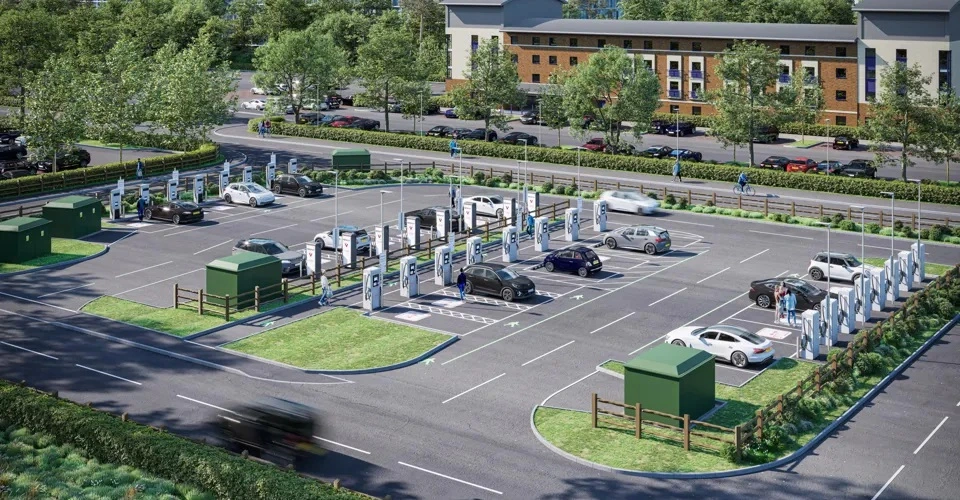In a world where urban areas are growing more congested and environmental concerns are at the forefront, the emergence of urban EV charging hubs is a game-changer. These innovative solutions are transforming city transport by making electric vehicle (EV) charging more accessible and efficient. According to Bloomberg Green, the number of public EV charging points worldwide surpassed 1.3 million in 2023, a staggering increase from previous years. This article will delve into how these urban charging hubs are reshaping city landscapes, enhancing sustainable mobility, and what it means for city dwellers and policymakers alike.
The Rise of Urban Charging Hubs
The Need for Urban Charging Infrastructure
As cities continue to densify, the demand for efficient and accessible EV charging infrastructure has skyrocketed. By 2023, more than 60% of the global population lives in urban areas, as the United Nations reports. Traditional petrol stations are slowly giving way to sophisticated EV charging hubs, strategically located to serve a growing fleet of electric cars.
- Key benefits include:
- Reduced range anxiety for EV owners
- Lower emissions contributing to cleaner air
- Enhanced convenience with multiple charging options
Urban charging hubs are more than just a pit stop for electric vehicles; they are becoming integral parts of smart city ecosystems. These hubs often include amenities like cafes, Wi-Fi, and retail shops, making the charging experience more pleasant and productive.
How Urban Charging Hubs Work
Urban EV charging hubs are designed to handle a large volume of vehicles, equipped with fast-charging stations that significantly reduce charging times. For instance, Tesla’s Supercharger V3 can add up to 75 miles of range in just 5 minutes, as highlighted by TechCrunch.
Features of modern urban charging hubs include:
- Fast Charging Stations: Capable of charging an EV to 80% in under 30 minutes.
- Solar Integration: Harnessing solar power to support green energy initiatives.
- Smart Technology: AI and IoT-enabled systems for efficient energy management.
- Flexible Payment Methods: Contactless payments and app-based systems for user convenience.
By integrating these features, urban charging hubs cater to a variety of needs, from quick top-ups to longer stays for a full charge.
The Impact on City Transport
Enhancing Sustainable Mobility
Urban EV charging hubs play a pivotal role in promoting sustainable urban mobility. CleanTechnica notes that the transportation sector accounts for nearly 30% of global carbon emissions, making it a critical focus for emission reduction efforts. By providing reliable charging infrastructure, cities can encourage the adoption of electric vehicles, thus significantly lowering their carbon footprint.
Positive impacts on city transport:
- Reduction in Traffic Congestion: Encouraging EV use can lead to more efficient traffic flow.
- Public Transport Integration: Linking with electric buses and shuttles enhances public transport networks.
- Decreased Pollution: Improved air quality and reduced noise pollution in urban areas.
Driving Economic Growth and Innovation
The establishment of urban EV charging hubs also stimulates economic growth. According to Reuters Mobility, the global EV charging infrastructure market is projected to reach $140 billion by 2030. These hubs create jobs, attract investment, and foster technological innovation.
- Job Creation: From construction to maintenance and management of hubs.
- Investment Opportunities: Real estate and tech investors are increasingly targeting charging infrastructure.
- Innovation: Encouraging advancements in battery technologies and energy management systems.
Practical Guide to Urban EV Charging
How to Charge Your EV at Urban Hubs
Charging your EV at an urban hub is designed to be a seamless experience. Here’s a step-by-step guide:
- Locate a Hub: Use apps like PlugShare or ChargePoint to find nearby charging stations.
- Check Availability: Ensure a charging spot is available and check the station’s compatibility with your vehicle.
- Connect and Pay: Plug in your vehicle, select your charging speed, and pay via app or contactless methods.
- Monitor Progress: Most hubs provide an app to track charging progress in real-time.
- Enjoy Amenities: Utilize available amenities while your car charges, such as Wi-Fi or coffee shops.
Where to Buy and Install Home Chargers
For those who prefer home charging, many brands offer solutions. Tesla, BYD, and Hyundai provide home charging units that are easy to install and use. When selecting a home charger:
- Compare Charging Speeds: Level 1 chargers are slower but more affordable, while Level 2 chargers offer faster charging times.
- Check Compatibility: Ensure the charger is compatible with your vehicle and home electrical system.
- Consider Installation Costs: Professional installation may be required, so factor this into your budget.
Conclusion: The Future of Urban Mobility
Urban EV charging hubs are not just a trend; they are a transformative force in modern city transport. By 2023, these hubs continue to evolve, offering faster, more efficient, and environmentally friendly solutions for urban mobility. As more cities embrace this change, the shift towards a sustainable future becomes inevitable.
Are you ready to join the electric revolution? Whether you’re an EV owner, city planner, or investor, there’s a role for everyone in shaping the future of urban transport. With continuous innovation and growing infrastructure, the path forward is electrifying. As we look ahead, the integration of renewable energy sources and smart technology promises an even brighter future for urban EV charging hubs worldwide.

